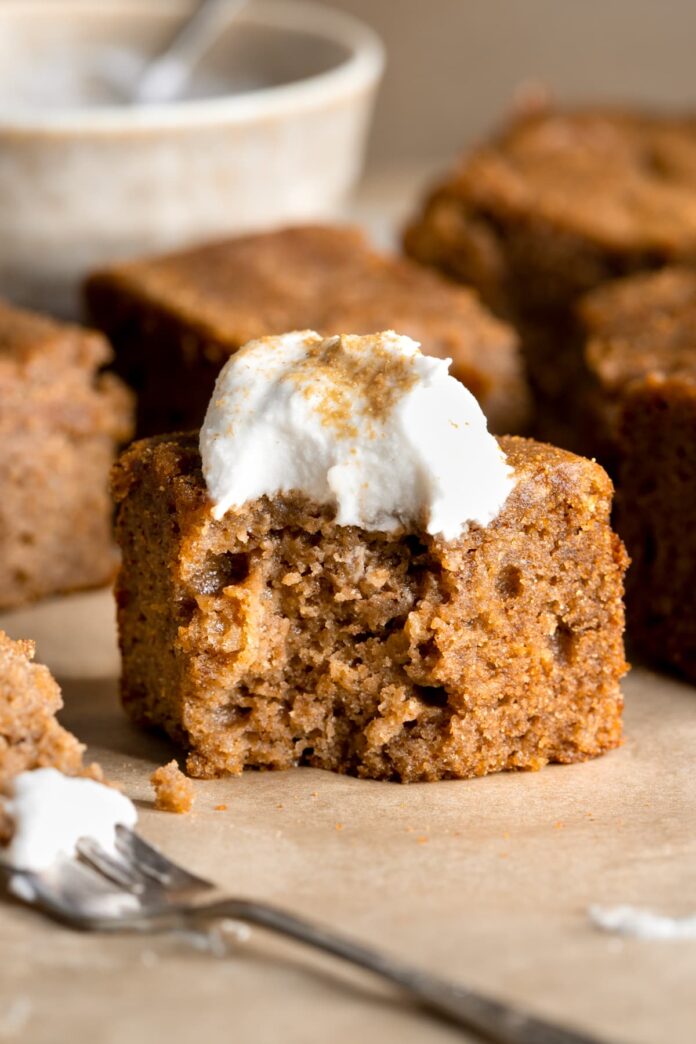This Gluten Free Gingerbread Cake without Molasses is an easy and healthy alternative to traditional gingerbread. Baked in a loaf tin, the cake is super moist, flourless and dairy free with a paleo option. Perfect if you want to bake something to get yourself into a festive mood.
As you will see below, the recipe includes some clever swaps to keep the cake on the healthier side without compromising on taste. At the end of the day, you want your gingerbread cake to be sweet, sticky and filled with Christmas spices.
Healthy gingerbread cake
To make this healthy gingerbread cake, I swapped some of the traditional ingredients to include more whole foods and to keep the recipe gluten and dairy free:
- Baked potato instead of flour: By using baked potato instead of flour, this gingerbread cake is completely flourless, gluten free and grain free. The potato also stops the cake from drying out and gives it a beautiful moist texture.
- Reduced sugar: The cake is sweetened with just enough golden syrup to balance out the spices. This replaces the more typical gingerbread sweeteners like molasses, honey and brown sugar. For a paleo friendly option, you could use maple syrup instead of golden syrup.
- Dairy free option: Coconut oil replaces butter to keep this gingerbread cake dairy free. I have no issues with dairy or butter personally, but a lot of people have to avoid dairy.
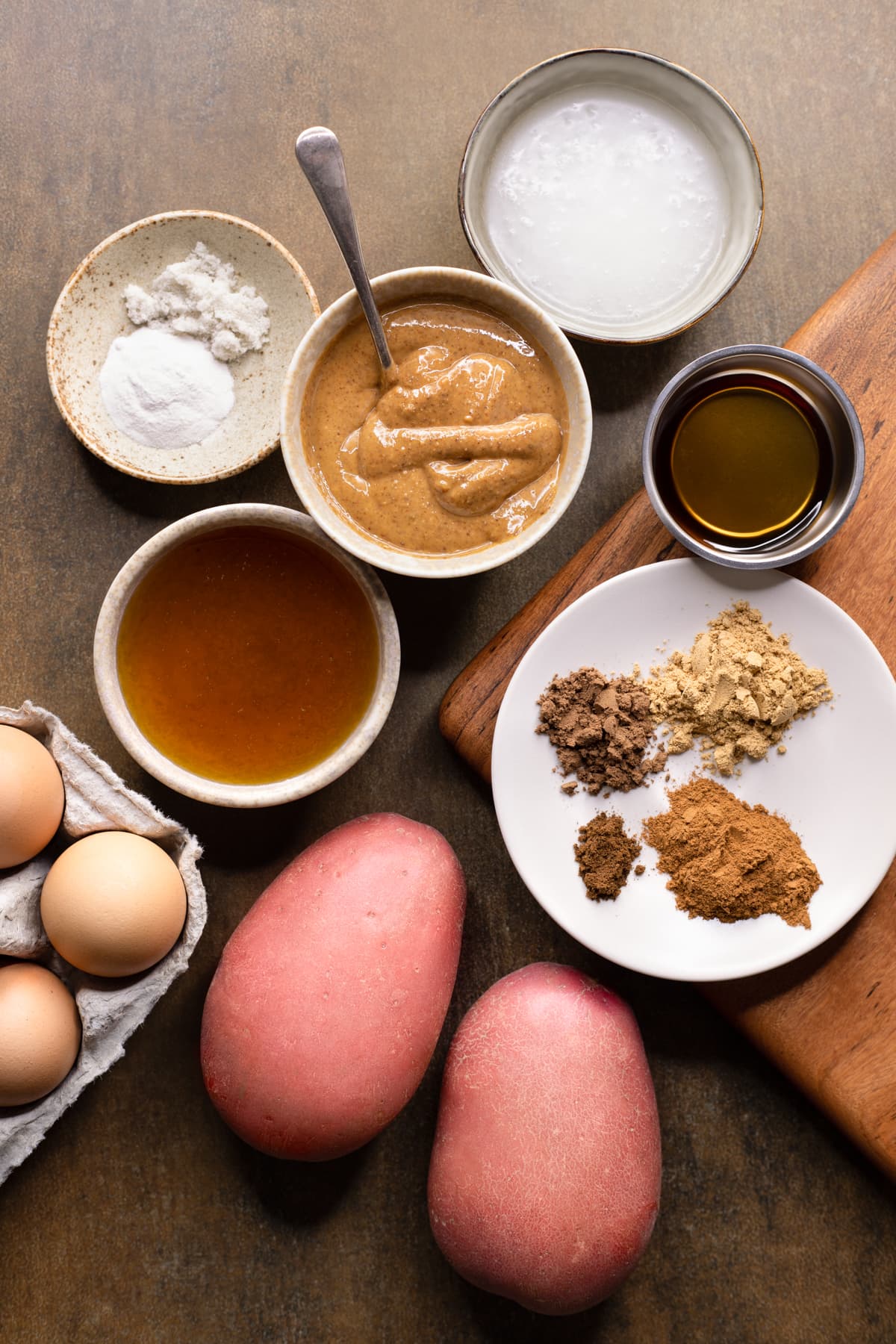
What is the difference between gingerbread and ginger cake?
Gingerbread is a broad term used to describe a range of baked goods flavored with ginger, cinnamon, cloves and molasses, honey, treacle or brown sugar. Think gingerbread men, gingerbread cookies, a gingerbread house and gingerbread cake or gingerbread loaf.
Ginger cake usually just means gingerbread in cake or loaf form. A good ginger cake or gingerbread loaf is moist in texture with just the right balance of sweetness and spices. Using baked potato instead of flour in this gluten-free gingerbread cake helps to provide that perfect moist texture.
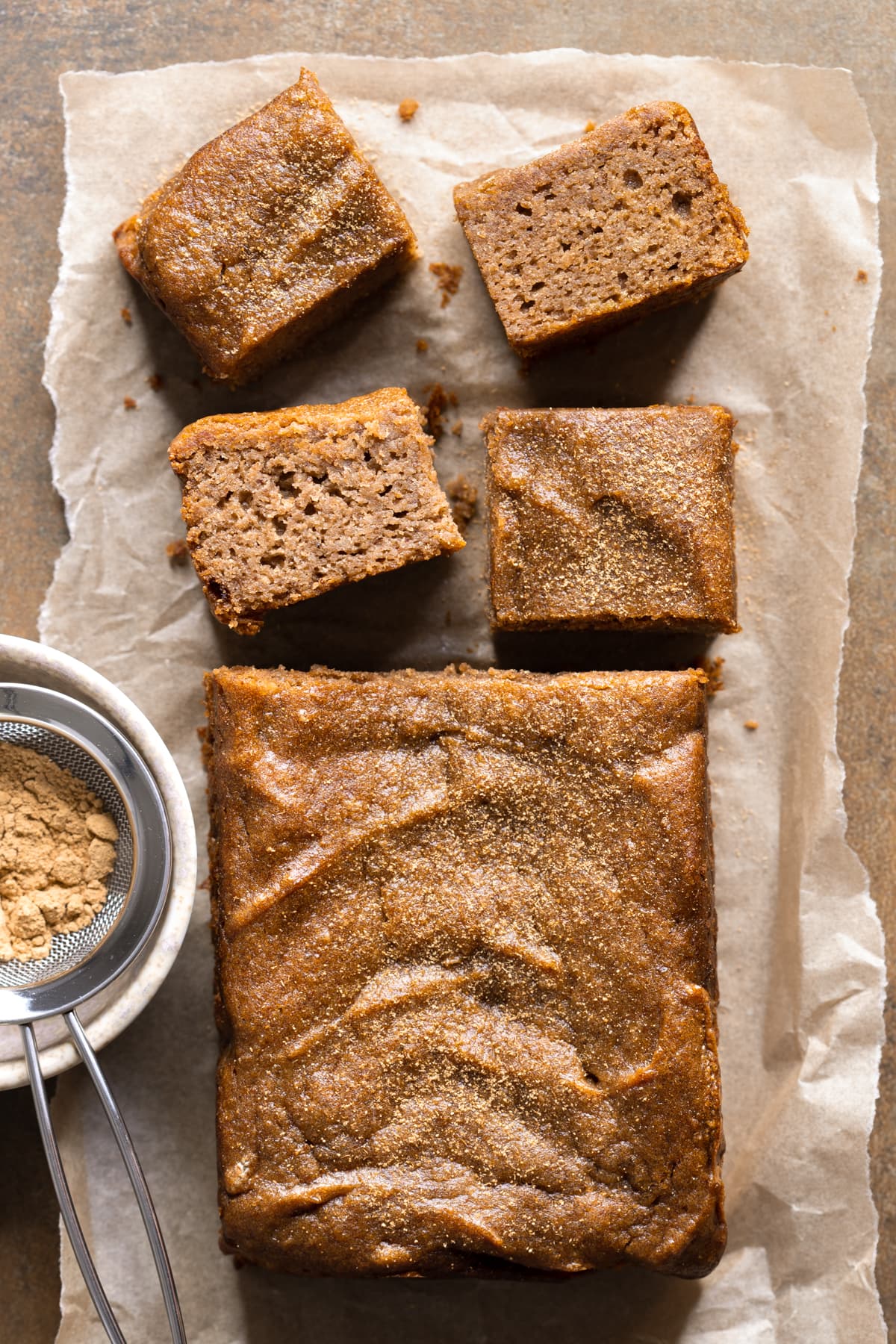
Why was my ginger cake dry?
When a cake turns out dry, it usually means that you added too much flour. If a recipe doesn’t state the amount of flour in grams, it can be very easy to add too much when using cup measures.
The good news is that this gluten-free gingerbread cake recipe uses baked potato instead of flour, so it’s a lot less likely to dry out. However, I still recommend weighing the baked potato in grams for best results. Food scales are inexpensive these days and they will help you to avoid disappointing results when baking.
What can I use instead of molasses?
Golden syrup replaces molasses in this gingerbread cake. Golden syrup is also known as light treacle and it’s widely available in the UK and Australia. It has a texture similar to honey and makes a great substitute for molasses. To replace the depth of flavor usually provided by molasses, I add a generous amount of spices to the recipe, including ginger, cinnamon, allspice and cloves.
Can I use honey instead of golden syrup?
You can certainly use honey instead of golden syrup in this gingerbread recipe. Just keep in mind that honey has quite a strong flavor, so the gingerbread will taste a bit like honey. I have also made this recipe with maple syrup instead of the golden syrup.
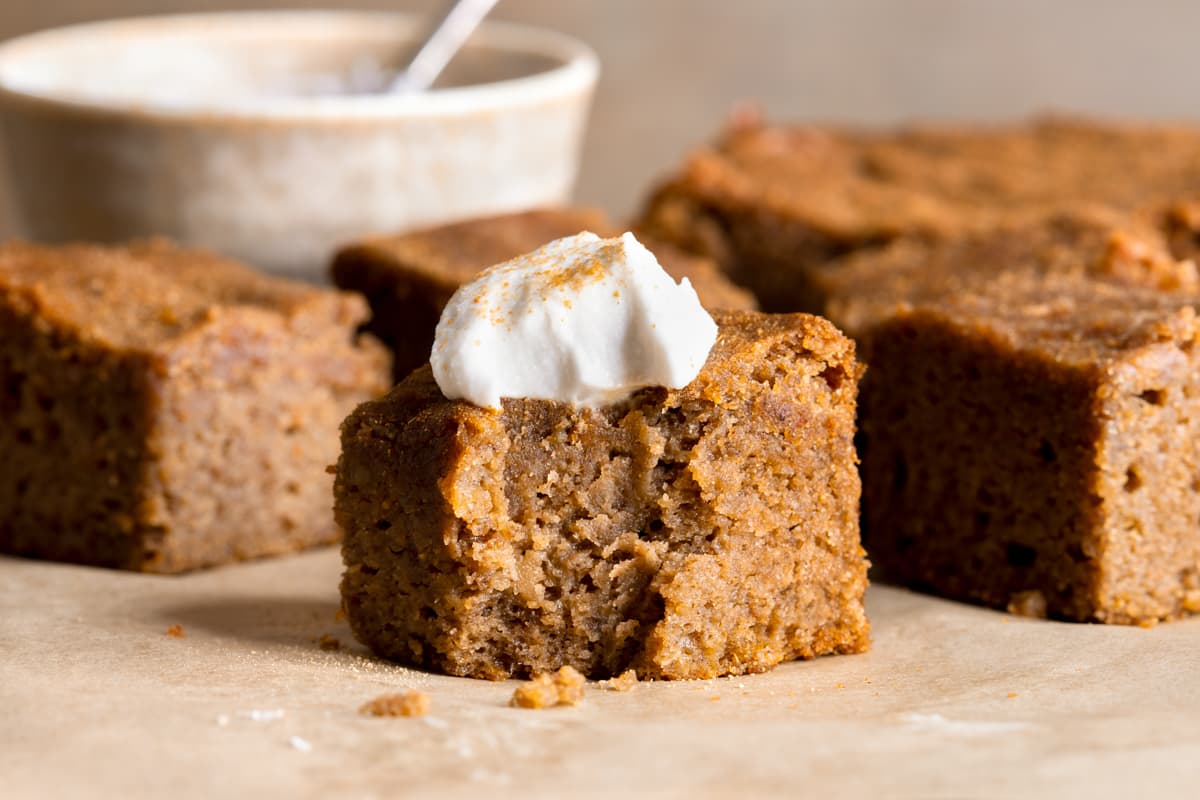
Ingredients for gluten free gingerbread cake
- Red potato: Baked potato is used instead of flour to keep the cake gluten free, grain free and flourless. I use red potatoes, which have red skin and yellow flesh.
- Golden syrup: To sweeten the cake and provide a classic gingerbread flavor. You can use maple syrup or honey if you prefer.
- Coconut oil: Used instead of butter to keep the gingerbread cake dairy free. We don’t use a lot, so the cake doesn’t taste like coconut.
- Almond butter: Works with the coconut oil to replace butter. Almond butter gives the cake a darker brown gingerbread color, but you could also use cashew butter or another nut butter if you prefer.
- Egg: To bind the cake and hold everything together. I haven’t tested the recipe with an egg substitute, but if you try this I’d love to hear how it goes.
- Ginger, cinnamon, allspice and cloves: These ground spices are my ultimate gingerbread spice mix. Ginger is the key spice, but you can adjust the other spices if you prefer. Mixed spice can be used as an alternative if that’s what you have at home.
- Vanilla extract: A great addition to any cake. It works really well with the gingerbread spices.
- Baking powder: To give the cake some lift and to lighten the texture. Make sure your baking powder is within its best before date to ensure that it works properly.
- Salt: Brings out the flavors of the cake. Always essential in my opinion.
- To serve: You can serve the gingerbread with whipped coconut cream or a coconut-based ice cream to keep things dairy free.
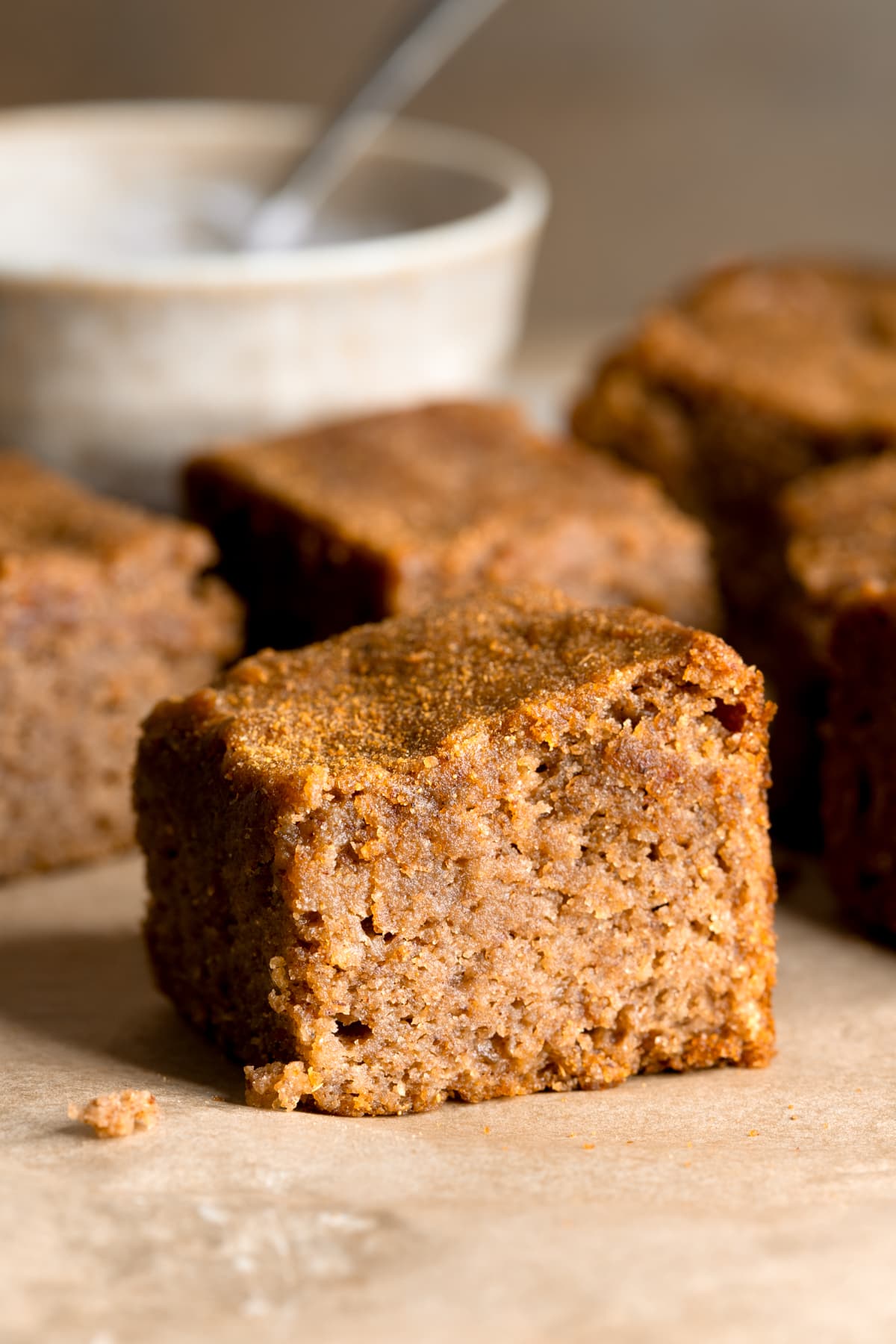
More gluten free baking recipes
- Gluten Free Gingerbread Cookies with Almond Flour
- Flourless Zucchini Brownies with Chocolate Frosting
- Gluten Free Apple Cake with Buckwheat Flour
- Almond Flour Double Chocolate Zucchini Muffins
- Vegan Sweet Potato Chocolate Fudge Cake
Check out the Baking Recipes page for more healthy baking ideas.
Gluten Free Gingerbread Cake without Molasses Recipe
Serves
10 pieces
Prep time
20 mins
Cook time
50 mins
Ingredients
- 18 oz / 500 g red potatoes (to give 3/4 cup / 180 g cooked flesh)
- 1/2 cup / 120 ml / 170 g golden syrup (see Note 1)
- 1/4 cup / 60 ml / 54 g coconut oil, softened
- 2 tsp vanilla extract
- 1 egg
- 1/2 cup / 120 g almond butter
- 1 tsp ground ginger
- 1 tsp ground cinnamon
- 1/4 tsp ground allspice
- 1/8 tsp ground cloves
- 1 tsp baking powder
- 1/4 tsp fine salt
Method
- Microwave or bake the potatoes, skin on, until the flesh is soft (see Notes 2 and 3). Extract 3/4 cup / 180 grams of the cooked flesh to use in the cake.
- Preheat your oven to 160°C fan-forced / 180°C / 350°F and line a 4 x 8 inch / 10 x 20 cm loaf tin with baking paper.
- Place the cooked potato flesh and remaining cake ingredients into a mixing bowl. Blend with a hand blender until smooth. Alternatively, you can blend everything in a food processor.
- Spoon the mixture into the lined tin, spreading it evenly with the back of a spoon. Bake in the preheated oven for 50 minutes or until a skewer inserted into the centre comes out clean.
- Allow the cake to cool, then transfer to the fridge in an airtight container until ready to eat. Serve on its own or with whipped coconut cream.
Notes
- Golden syrup substitutes – You can use maple syrup or honey instead of golden syrup. I talk about why I use golden syrup in the post above.
- Microwave your potato – Prick the potatoes all over with a fork, place on a microwave safe plate and microwave for about 15 minutes, flipping the potatoes over half way, or until a knife inserted into the thickest part of each potato slides through easily. Allow to cool slightly before peeling off the skin and extracting the flesh to measure out for the recipe.
- Bake your potato in the oven – Prick the potatoes all over with a fork, place on a baking tray and bake in a 180°C fan-forced / 200°C / 400°F oven for 30 to 40 minutes or until a knife inserted into the thickest part of each potato slides through easily. Allow to cool slightly, then peel off the skin and extract the flesh to measure out for the recipe.
- Storage – Store the cake in an airtight container in the fridge for up to 3 days. I say 3 days because this is usually how long cooked potato lasts in the fridge. Alternatively, you can freeze the cake and defrost in the fridge as needed.
Nutrition Facts
- Serving size: 1 piece
- Energy: 198 Calories / 830 Kilojoules
- Total Fat: 11.5 g
- Saturated Fat: 5.1 g
- Total Carbohydrate: 18.7 g
- Dietary Fiber: 0.6 g
- Sugars: 14 g
- Protein: 4 g
- Sodium: 120 mg
- Potassium: 181 mg
